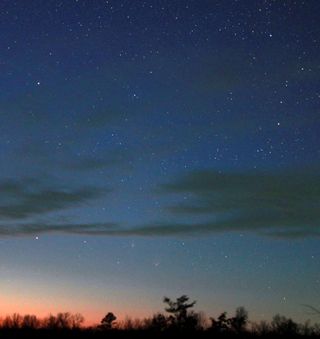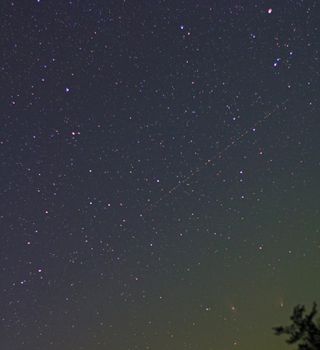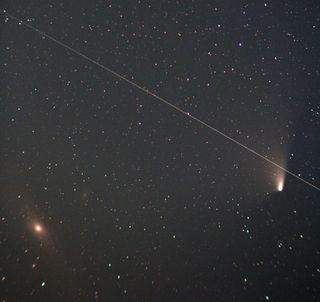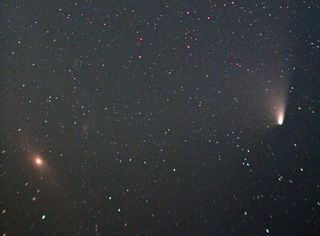
Capturing a Comet-Galaxy Conjunction
Victor Rogus is an amateur astronomer, and this is the eighth in his series of exclusive Space.com posts about amateur astronomy. He contributed this article to Space.com's Expert Voices: Op-Ed & Insights.
I was prepared well in advance for a most exciting event to occur on the night of April 4 and the morning of April 5, 2013: the conjunction of comet Pan STARRS (C/2011 L4) and the great galaxy, Andromeda (M-31). This certainly was one of those once-in-a-lifetime events.
My wife has been keen to point out that in the field of astronomy, "once-in-a-lifetime" events seem to occur regularly. That may be true, but the conjunction was going to be a good one, and only possible to capture for a few short hours, and only on this night. The most important requirements would be an unobstructed eastern and western horizon. And because we live deep in the backwoods of Dent County, Missouri, where the sky is very dark, one has to hunt for good, low horizons. That meant tearing around the backwoods gravel roads in a pickup truck with a chainsaw and a compass searching out the required azimuth readings on a standard compass.
After a while, I felt I had found the perfect horizons about a mile from home, a nearly perfect back-to-back setup for due east and due west. This was exactly what I needed: not too far apart, and each afforded me a very low horizon. Because the comet and galaxy were circumpolar (continually visible throughout the evening or in this case dipping below the western horizon to re appear in the east before dawn.), they would be visible at sunset in the west for a short time until setting below the horizon. Then, before dawn, the two would rise again — though in the east, just ahead of sunrise. Long before rising that night, I set a plan in motion. I would set up my mount and cameras in the evening in the west to try and capture the pair in a wide-angle format, and then return pre-dawn with a small telescope and try to capture a closer view.
Then came the chainsaw. My selected observation points were on rocky outcroppings of newly logged Ozark mountain ridges. This was rugged, uneven land full of stumps, rocks, brush piles and the like. Every piece of usable timber — walnut, red and white oak, and pine — had been removed from this land and sold to the lumber market. What was left would be sold as parcels of land for hunters and anyone strong enough to turn some of the worst land in Missouri into a building site for a home in the backwoods. For my photography, a few scrub brushes and badly damaged trees needed be cut down and removed from the scene to prevent them from ruining my amazing photo op. I would never damage a healthy tree. With this cleaning up of my locations finished, I placed a set of markers on the ground and was left with nothing to do but to pray for clear skies.
The latitude at the site was 37.5 degrees, and some amateur astronomers suggested that the celestial pair in conjunction could not be seen from there, as they would be too low on either horizon. But eventually, it was time to try.
The first part would be the easier of the two setups. I arrived and set up my equipment in the daylight at the western-horizon vantage point and watched a beautiful sunset with only a few wispy clouds near the horizon to make me nervous. A couple of the stars of the constellation Cassiopeia would serve as rough pointer stars to the great messier object and the comet, and scanning with my binoculars, I joyously found both low on the horizon.
Get the Space.com Newsletter
Breaking space news, the latest updates on rocket launches, skywatching events and more!

Then, it was time to reorganize my equipment, take a nap, and head back out into the dark and cold to make my close-up versions of this historic event. The buzzing of an alarm clock at 2:00 a.m. is a harsh thing. I lay there considering my options. I could stay right there in bed, be satisfied with the images made earlier — a tempting thought. But as the groggy fog of sleep lifted, I knew I had to go. It was a chance of a lifetime; I just had to tough it out.
Where I live deep in the backwoods, the skies are very dark, and all kinds of animals — mountain lions, bears and the like — roam the darkness of our neighborhood. I would be all alone when I set up my equipment at the eastern horizon site. It can be a bit scary. I hate to set up in the dark, but I went about my work and captured my images.

My site was waiting for me — it was very dark and very cold — and I went to work setting up, polar aligning and balancing my telescope. The sounds of owls and night birds filled the air. Shivering from the cold, I scanned the sky with binoculars, until BAM! There they were! Slewing the telescope, I began to make my images. Tracking the pair, I made many images. In one, I thought I had captured a meteor intersecting the comet's tail — I just could not tell in the field. When I inspected it at home, it turned out to be a satellite.


It was kind of a rough night, but I was able to capture something I will likely never see again — an amazing memory that I am proud to share. The Andromeda Galaxy can be seen many nights out of the year, but those special times when this galaxy is adorned by a comet just about as bright as itself makes the effort well worth it, and I was very pleased with my results.

Indeed, the skies provide wondrous sights — a lot of planning and preparation will allow you to see them and photograph them. You never know how your image will look until it is over and done. All we can do is our best with what we have, and that must be enough. But planning and improving for the next adventure will only ensure better images of many more once-in-a-lifetime events to come.
I wish to dedicate this story and these images to my Dad, Dennis Rogus, “The King of the Toolmakers” who passed away suddenly and unexpectedly at the age of 87 He taught me how to build things and was the first person to introduce me to the stars. He was a fine father and will be missed by us all.
Space.com is hosting a slideshow of Rogus' night sky images.
Rogus' most recent Op-Ed was "Celestial Showstopper: The Only Venus Transits I'll Ever See." The views expressed are those of the author and do not necessarily reflect the views of the publisher. This version of the article was originally published on Space.com.
Join our Space Forums to keep talking space on the latest missions, night sky and more! And if you have a news tip, correction or comment, let us know at: community@space.com.
